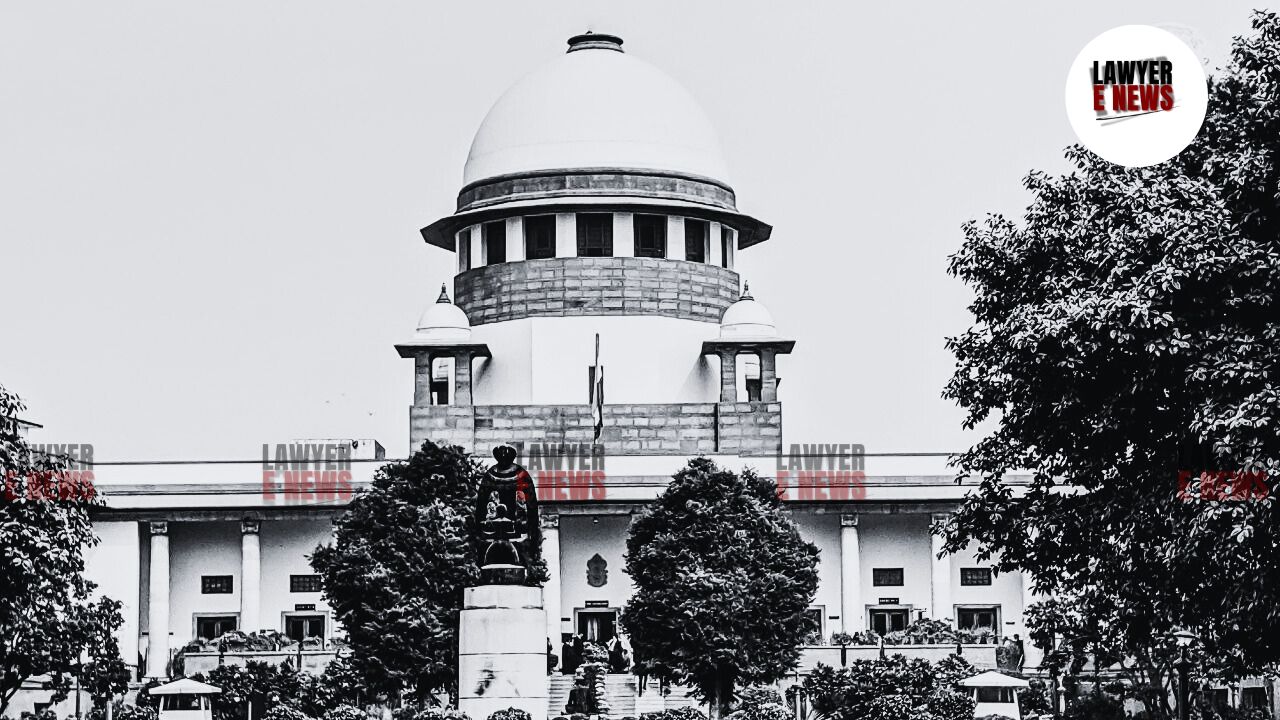-
by Admin
17 December 2025 4:09 PM



Recovery Process Marred by Procedural Lapses, Raising Serious Doubts on Evidence - In a significant ruling Supreme Court of India acquitted Raja Khan, who had been sentenced to life imprisonment under Section 302 IPC and five years of rigorous imprisonment under Section 201 IPC for allegedly murdering Neeraj Yadav. The Court found that the prosecution failed to establish an unbroken chain of circumstantial evidence, thereby entitling the appellant to the benefit of doubt.
The bench of Justices Sanjay Karol and Manmohan ruled that the last seen theory was uncorroborated, the recovery of weapons and gold chains was procedurally flawed, and the seizure memos raised serious doubts about the credibility of the prosecution's case. Applying the five golden principles of circumstantial evidence laid down in Sharad Birdhichand Sarda v. State of Maharashtra, (1984) 4 SCC 116, the Court concluded that the prosecution failed to prove guilt beyond reasonable doubt.
"The prosecution must establish a complete and unbroken chain of circumstances leading conclusively to the guilt of the accused," the Court observed. "When the last seen theory lacks corroboration, the recovery process is flawed, and the identification of key evidence is unreliable, conviction cannot be sustained."
"Last Seen Theory Must Be Corroborated—Unsubstantiated Testimony is Insufficient"
The prosecution argued that the deceased was last seen with Raja Khan on November 29, 2013, relying primarily on PW-23’s testimony. However, the Supreme Court found that this claim was not supported by independent witnesses and failed to meet the standard of proof required in circumstantial evidence cases.
"PW-23’s statement remains uncorroborated by PW-2, PW-3, and PW-5," the Court held. "It is a well-settled principle that when the case rests entirely on circumstantial evidence, the last seen theory, if not supported by independent and consistent evidence, cannot alone be the basis of conviction."
The Court reiterated that mere proximity between the accused and the deceased before the death does not establish guilt, unless it is accompanied by further incriminating evidence linking the accused to the crime.
"Recovery Process Must Adhere to Legal Standards—Procedural Irregularities Cast Doubt on Prosecution’s Case"
The prosecution heavily relied on the recovery of a Gandasa (battleaxe), a stone, and gold chains allegedly belonging to the deceased. However, the Supreme Court found serious procedural lapses in the recovery process, stating that the entire basis of the evidence stood compromised due to irregularities in seizure memos and police conduct.
"PW-22 admitted that he and another witness signed multiple seizure memos at the police station, rather than at the scene of recovery," the Court noted. "This is a serious breach of procedure, raising grave doubts about the authenticity of the recovery itself."
The Court also highlighted that PW-26, the diver who retrieved the alleged murder weapon from the pond, stated that he acted on police instructions rather than at the behest of the accused. "Recovery loses evidentiary value when it is dictated by police rather than leading to the discovery of a fact unknown to them," the judgment emphasized.
Referring to Bodhraj Alias Bodha v. State of J&K, (2002) 8 SCC 45, the Court reiterated that for a Section 27 Evidence Act disclosure to be valid, the accused must directly lead to the discovery of the evidence, which was not the case here.
"When seizure memos are signed at the police station rather than at the recovery site, they lose their evidentiary value," the Court observed. "A recovery based on police directions rather than an accused's voluntary disclosure cannot be relied upon to establish guilt."
"Flawed Test Identification Parade (TIP) of Gold Chains—Pre-Exposure to Witnesses Renders Identification Unreliable"
The Supreme Court questioned the reliability of the Test Identification Parade (TIP) conducted for the gold chains allegedly belonging to the deceased, noting multiple procedural violations.
"The TIP was fundamentally flawed as witnesses stated that only two gold chains were placed for identification, contradicting the official procedure that requires multiple similar items to be used," the Court noted. "Further, PW-2 admitted receiving the gold chains at the police station a day before the TIP, raising concerns of pre-exposure and coaching."
The Court found that no distinct identification marks or features linking the gold chains to the deceased were presented, rendering the evidence unreliable. "When an item lacks distinctive characteristics, its identification by witnesses who have already seen it in police custody raises serious doubts about the fairness of the procedure," the Court held.
"Prosecution Must Prove Guilt Beyond Doubt—Circumstantial Evidence Requires a Complete Chain"
Applying the five golden principles of circumstantial evidence from Sharad Birdhichand Sarda v. State of Maharashtra (1984) 4 SCC 116, the Supreme Court found that the prosecution had failed to establish a conclusive case against Raja Khan.
"The chain of circumstances must be so complete that it excludes every possible hypothesis except the guilt of the accused," the Court stated. "Here, the broken links in the chain of evidence, the contradictions in witness testimonies, and the procedural irregularities in the recovery process all create reasonable doubt."
Citing Hanumant v. State of Madhya Pradesh (1952) 2 SCC 71, the Court reaffirmed that a conviction cannot be based on circumstantial evidence unless it points unerringly to the accused, excluding all other possibilities.
"When the evidence is riddled with inconsistencies and procedural lapses, and the prosecution fails to establish a clear motive, the accused is entitled to the benefit of doubt," the judgment concluded.
"Supreme Court Sets Aside Conviction—Orders Immediate Release of Raja Khan"
Holding that the prosecution failed to meet the burden of proof, the Supreme Court set aside the conviction and directed Raja Khan’s immediate release unless required in any other case.
"The appellant is entitled to the benefit of doubt," the Court ruled. "The conviction is set aside, and the appeal is allowed. The appellant shall be released forthwith unless detained in another matter."
"A Landmark Judgment on the Importance of Procedural Fairness and Evidentiary Standards"
This ruling reaffirms the Supreme Court’s commitment to ensuring procedural fairness in criminal trials. The judgment underscores that:
Last seen theory must be corroborated by independent evidence.
Recovery under Section 27 Evidence Act must be at the instance of the accused, not dictated by police.
Test Identification Parades must follow strict procedural safeguards.
Convictions cannot be sustained on broken chains of evidence.
By acquitting Raja Khan, the Supreme Court has sent a strong message on the necessity of adhering to proper legal procedures in cases based on circumstantial evidence. This case serves as a precedent for ensuring that convictions are based on legally sound and reliable evidence, rather than procedural shortcuts and assumptions of guilt.
Date of Decision: 07/02/2025
